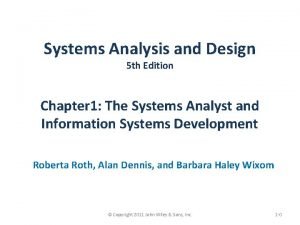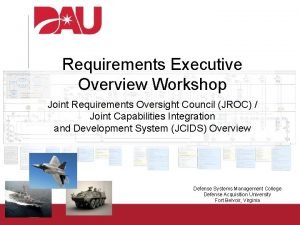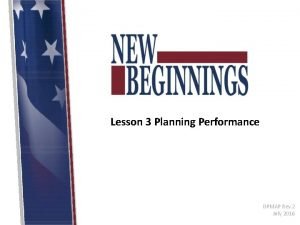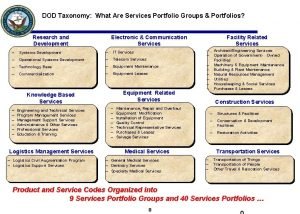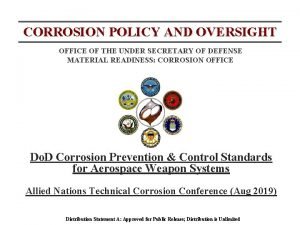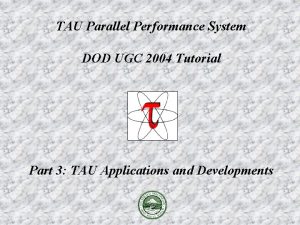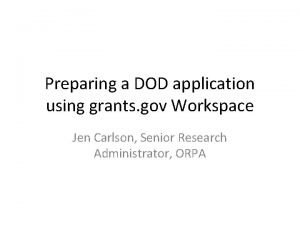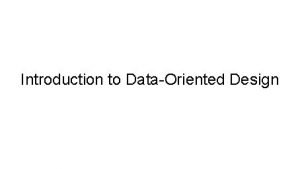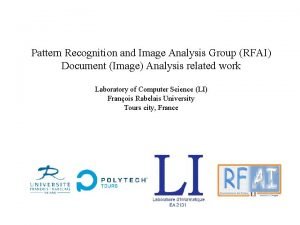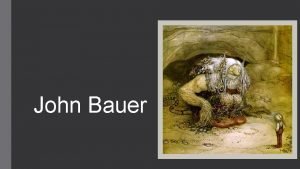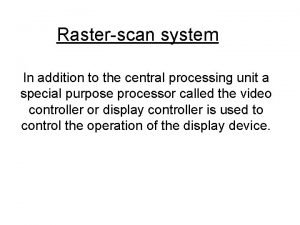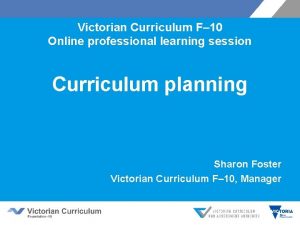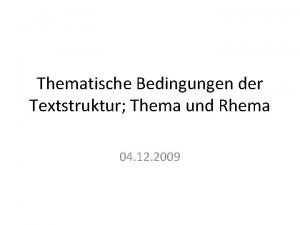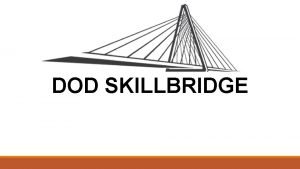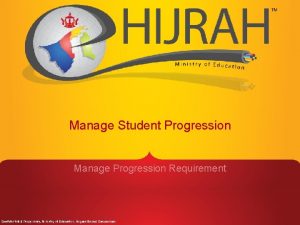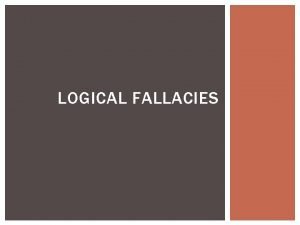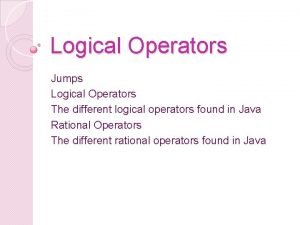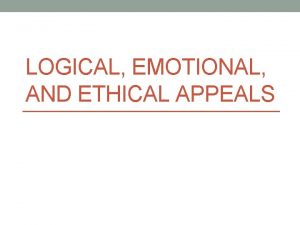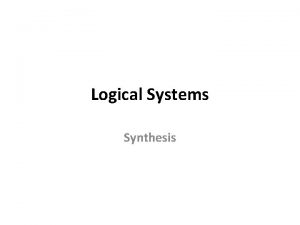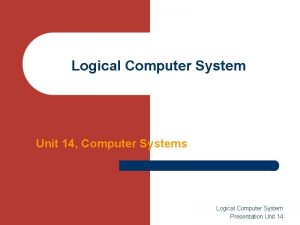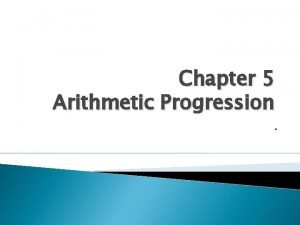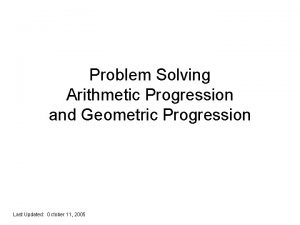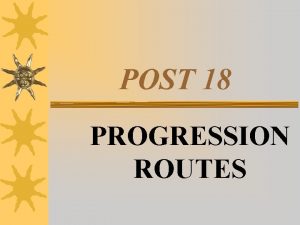PURPOSE A logical progression of how DOD systems
































- Slides: 32

PURPOSE : A logical progression of how DOD systems are developed, tested, produced and fielded. Provides the PM with a master planning tool for checking the completeness of the program planning effort. Displays the critical program events.

The winds of change…… DODD 5000. 1 DODI 5000. 2 . . are blowing again!

PROGRAM CATEGORY MANAGER MILESTONE DECISION AUTHORITY HIGEST REVIEW BODY COST THRESHOLD ACAT 1 D PEO/PM DAE - USD(A&T) DAB > $365 m RDTE $2. 190 b PROC ACAT 1 C PEO/PM AAE - ASA(ALT) ASARC ACAT 2 PEO/PM AAE - ASA(ALT) ASARC $140 m RDTE $660 m PROC ACAT 3 PEO/PM Designated by AAE IPR ACAT 4 PEO/PM Designated by AAE IPR BELOW ACAT 2 SPECIAL INTEREST ITEM –HIGH VIS ALL OTHERS

Co – chaired by the VCSA and the AAE membership includes: • • Deputy Under Secretary of the Army (Operations Research) Office of Army Int’l Affairs, Army G-3 ASA (Financial Mgmt & Comptroller) ASA (Manpower and Reserve Affairs) CG AMC CG TRADOC DCS, G-4 DCS, G-3 • • • DCS Personnel DCS Intelligence Chief, Army Reserve Chief, National Guard Bureau CG, OPTEC Military Deputy to ASA (ALT)

If sufficient number of management layers are superimposed on top of each other, it can be assured that………. disaster is not left to chance.

Process entry at Milestones A, B, or C (or within phases) Appropriate point is guided by the ability to satisfy entrance criteria Technology Opportunities & User Needs A B Concept & Technology Development IOC C System Development & Demonstration Production & Deployment OT&E Pre-Systems Acquisition FOC Operations & Support FRP Decision Review Systems Acquisition (Engineering and Manufacturing Development, Demonstration, LRIP & Production) Sustainment Block 2 Block 3

Def Panning Guidance Combatant Commander Threat Intel National Security Strategy MISSION AREA ANALYSIS Capability deficiencies in operational and support tasks needed to meet mission objectives. User Changes: Doctrine Organizations Training Leader Dev Soldier Mission Need Analysis NO Materiel Solution YES Mission Need Statement

Mission Need Statement developed. Develop requirements in the form of Capstone Requirements Documents and Operational Requirements Documents. Accomplished within the Defense Science and Technology Program Technology Opportunities & User Needs A B Concept & Technology Development IOC C System Development & Demonstration Production & Deployment OT&E Pre-Systems Acquisition (Engineering and Manufacturing Development, Demonstration, LRIP & Production) FOC Operations & Support FRP Decision Review Sustainment Block 2 Block 3

• Technologies are identified within DOD labs, academia, and commercial sources. • Technologies are matured for those with most promise for application to weapon systems. • Three mechanisms are used to transition to the user or systems acquisition community: – Advanced Technology Demonstrations – Advanced Concept Technology Demonstrations – Experiments

• Expressed as measures of effectiveness or performance • Minimum acceptable requirements • Comprised of time phased thresholds and objectives (including cost) • Examples of required capabilities - system performance (range, accuracy, payload, speed survivability etc. ) - logistics and readiness (mission capable rate, frequency and duration of maintenance actions, mobility, BDAR) - interoperability

• The last 10% of performance sought generates one-third the cost and two-thirds the problems

OBJECTIVE CREW SERVED WEAPON FUTURE COMBAT SYSTEM TECHNOLOGIES SCIENCE AND TECHNOLOGY PROGRAMS MINE HUNTER/KILLER

A Milestone Decision Authority approves the initiation of concept studies, designates a lead component and issues an Acquisition Decision Memorandum Concept Exploration Decision Review (Optional) Paper studies of alternative concepts for meeting a need (Analysis of Alternatives) Before program initiation. . Acquisition Strategy is developed Acquisition Program Baseline is established Test Evaluation Master Plan drafted PM is assigned Component Advanced Development Are key technologies sufficiently mature to enter System Development and Demonstration? Component development contracts Demonstrate technology in a relevant that has only been demonstrated in a laboratory environment. Develop a system architecture (appropriate set of subsystems to be integrated). Reduce Risk

• Minimize time and cost of satisfying the need consistent with common sense and sound business practices • Tailored to meet specific needs of individual programs • Approved at program initiation (Milestone B) by the MDA • Addresses interrelationships of the essential program elements Open Systems Competition Contract Approach Sources of Supplies or Services Modeling and Simulation Risk Management International Cooperation Cost as an Independent Variable Management Approach Source of Support Commercial/Non-developmental Technologies Environmental Considerations

USER PROGRAM MANAGEMENT MANUFACTURING CONTRACTING SCIENCE & TECHNOLOGY SYSTEMS ENGINEERING TEST & EVAL SOFTWARE MANAGEMENT BUSINESS, COST ESTIMATING AND FINANCIAL MANAGEMENT ACQUISITION LOGISTICS THE ACQUISITION COMMUNITY SUPPORTS THE USER Note: Integrated Product and Process Development (IPPD) links all disciplines toward this goal.

VARIOUS IPT LEVELS CONTRACTOR PROGRAM MANAGER MATRIX SUPPORT PMO STAFF

20 2. 0 15 Members of U. S. Senate 1. 5 10 1. 0 Median duration of development programs over period shown YEARS (Experience in job measured in development periods) PERSONNEL STABILITY IN THE ACQUISITION PROCESS 5 0. 5 Government Program Managers 1975 1980 1985 Year of Termination 1990

The problem with the acquisition process is that by the time the people at the top are ready for the answers, the people at the bottom have forgotten the questions.

• Concept inherent in Acquisition Strategy and ORD • Sets aggressive cost objectives early in the development effort • Discourages the pursuit of costly performance enhancements of limited operational value • CAIV based tradeoff analyses are the basis for refining requirements and establishing cost, performance, and schedule goals at successive milestone decisions • Tradeoffs evaluated in relation to risk

• Projected program cost $12. 875, 300, 000 Adjusted cost a few years later - $24, 023, 300, 000 The weaker the data upon which to base one’s position, the greater the precision which should be quoted in order to give that data authenticity

COMMON MISSILE AERIAL COMMON SENSOR PROGRAMS IN CONCEPT AND TECHNOLOGY DEVELOPMENT

Entrance into this phase is dependent on three things…. . Technology Maturity Validated Requirements Funding Program Initiation B System Integration Integrates subsystems and components into a complete system. Prototypes successfully demonstrated in a relevant environment. System Demonstration IPR Confirms program progress or adjust the plan Demonstrate the engineered system operates within an operational environment consistent with a validated ORD.

PROGRAMS IN SYSTEMS DEVELOPMENT AND DEMONSTRATION LAND WARRIOR HIMARS FBCB 2

Entrance Criteria: C Acceptable Interoperability Acceptable Operational Supportability Affordability Low – Rate Initial Production Full – Rate Production & Deployment (Major Defense Acquisition Programs and major systems) Provisionin g completed MFP approve d BOIP approved IOC FRP Decision Review (Type Classification STANDARD) FUE Establish full manufacturing Deploy system. capability (initial production base). Provide Initial Operational Test and Evaluation (IOT&E) and Live Fire Test and Evaluation articles. Conduct IOT&E (to include Log Demo) and LFT&E Fix deficiencies encountered in testing prior to Milestone C Not to exceed 10% of total production.

• Confirms adequacy of proposed support concept and programmed resources prior to acquisition • Integral part of both developmental and operational testing • Results compared against criteria outlined in system requirements and goals (ORD) • Conducted in the operational environment where the system will be used and maintained • Conducted using Army personnel (contractors may be utilized to the extent they will be involved in system support after fielding)

In order to be Type Classified Standard and approved for procurement…. • Item is a funded requirement in POM. • Adequate testing has shown the item to be operationally effective, suitable, survivable and supportable for the mission intended. • MTMC has provided transportability assessment. • USATA has provided a TMDE supportability assessment. • Safety and health hazards are controlled or eliminated. • Complete TDP (rights to use data for competitive procurement). • Producibility has been demonstrated. • Reliability and maintainability assessed and open issues and expected completion dates are identified. • LIN and NSN have been requested.

INTERIM ARMORED VEHICLE FORWARD AREA AIR DEFENSE COMMAND CONTROL PROGRAMS IN PRODUCTION AND DEPLOYMENT AUTOMATIC CHEMICAL AGENT DETECTOR/ALARM

Army Materiel Command Defense Logistics Agency FUED IOC DRMO Executes IAW: Legal and regulatory requirements relating to safety, security and the environment. Production & Deployment Supply. Maintenance SUSTAINMENT Safety FRP Configuration Management Data Mgmt DISPOSAL Trainin g Includes all elements necessary to maintain readiness and operational capability of deployed systems

Technology Opportunities & User Needs A B Concept & Technology Development IOC C System Development & Demonstration Production & Deployment OT&E FOC Operations & Support FRP Decision Review Follow-on Evolutionary Acquisition Strategy that defines, develops, tests, and produces/deploys an initial military capability while planning simultaneously for subsequent increments beyond the initial capability. Block 2 Block 3

This acquisition approach is preferred over the single step approach. ORD includes a definition of full capability as well as the requirements to be satisfied by each block (IOC for each block is identified). Acquisition strategy defines each block of capability and how it will be funded, developed, tested, produced and operationally supported. PM must balance the need to meet evolving user requirements against the ability of users to support continuing training and repeated deployments.

Do. D 5000. 2 -R cancelled and replaced with a guidebook Reduces verbiage and guidance Do. DD 5000. 1 reduced from 12 pages to 5 Do. DI 5000. 2 reduced from 46 pages to 28 Establishing two processes for evolutionary acquisition Incremental Development Spiral Development shall be the preferred process

Spiral Development – Desired capability is identified but end-state requirements are not known at program initiation. Requirements for future increments depend on technology maturation and continuous user feedback from initial increments.
 Logical progression definition
Logical progression definition Logical form and logical equivalence
Logical form and logical equivalence Equivalence statement definition
Equivalence statement definition Systems analyst career progression
Systems analyst career progression How dod judas die
How dod judas die Brig. gen
Brig. gen Dpmap performance elements
Dpmap performance elements Gustav vasas kröning
Gustav vasas kröning Dod evmig
Dod evmig Articles of the code of conduct
Articles of the code of conduct Dod patient safety program
Dod patient safety program Dod digital engineering strategy
Dod digital engineering strategy 2019 dod allied nations technical corrosion conference
2019 dod allied nations technical corrosion conference Fi muni dod
Fi muni dod Pablo picasso 1931
Pablo picasso 1931 Dod taxonomy
Dod taxonomy Mil-std-889
Mil-std-889 Dod
Dod Dod workspace
Dod workspace Data-oriented software design
Data-oriented software design Ralph lundsten död
Ralph lundsten död Dod gemcar
Dod gemcar Caroline zier dod
Caroline zier dod Dod logo
Dod logo Tuvstarr tavla
Tuvstarr tavla Give me a sentence
Give me a sentence Chapter 5 selecting a topic and a purpose
Chapter 5 selecting a topic and a purpose Display processor unit
Display processor unit National literacy and numeracy learning progressions
National literacy and numeracy learning progressions Vchpeh
Vchpeh Eal continuum
Eal continuum Victorian curriculum progression points
Victorian curriculum progression points Thematische progression
Thematische progression



